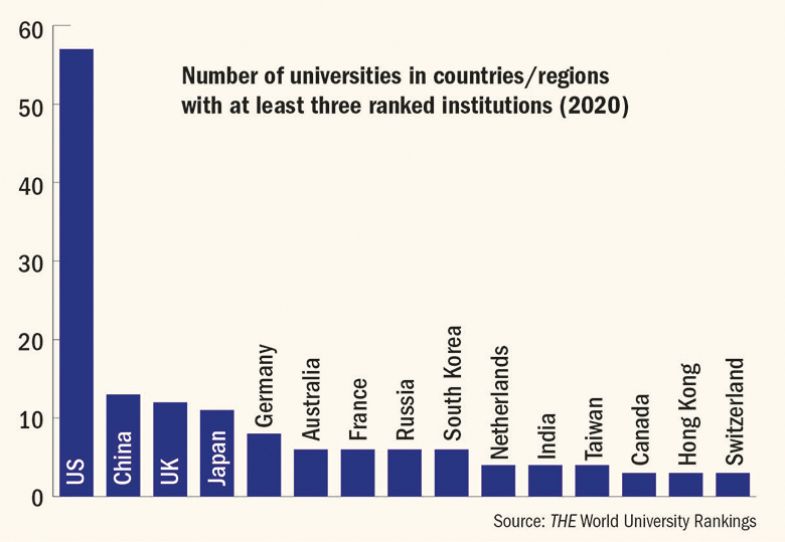View the full THE list of the world's most international universities 2020
The growing number of Asian academics and the improving quality of research in the region is shifting the global order of university prestige, according to an analysis of the data behind Times Higher Education’s latest list of the world’s most international universities.
The international ranking, which includes 170 universities, measures the share of international staff, students and co-authorship at institutions, as well as their international reputation. This last measure is based on THE’s Academic Reputation Survey, which asks leading scholars to name the world’s best universities for teaching and research in their field (see methodology below).
The latest data show that all ranked universities in China, Japan and Taiwan received more votes than they did last year from academics in their own countries as well as from academics internationally; thus, those nations have more institutional representatives in the table, and their previously ranked universities have improved their performances. India’s ranked institutions also received more votes from abroad.
China has 13 institutions in the international table this year, up from nine last year, and it is now the second most-represented nation in the ranking (behind the US). India and Taiwan both have four (up from two and one, respectively).
Hong Kong is home to the top two universities overall in the international table, while Malaysia and Thailand join the list for the first time this year.
Elsewhere, the data reveal, some Western universities are receiving fewer votes from their domestic scholars.
10 most international universities
|
International rank |
Institution |
Country/region |
|
1 |
Hong Kong |
|
|
2 |
Hong Kong |
|
|
=3 |
Switzerland |
|
|
=3 |
Switzerland |
|
|
5 |
Chinese University of Hong Kong |
Hong Kong |
|
6 |
United Kingdom |
|
|
=7 |
Singapore |
|
|
=7 |
United Kingdom |
|
|
9 |
United Kingdom |
|
|
10 |
Singapore |
|
|
Source: THE World University Rankings |
While all the UK’s 12 ranked institutions gained more votes from international scholars this year, three received fewer local votes. The picture is similar in Germany. Meanwhile, other institutions in the UK, Germany and Canada are not included in the table on account of their low share of domestic votes.
These changes are driven in part by the rising number of academics in Asia, given that the reputation survey is representative of the real distribution of scholars across the world based on discipline and country of origin and that Asian universities still tend to receive most of their votes from academics based within their own country.
Places plugged into international currents

However, the growing number of international votes for Asian universities suggests that they are also gaining recognition more broadly, perhaps because of the rising quality of research in the region.
Janet Ilieva, founder and director of Education Insight, a research consultancy specialising in international higher education, said the findings suggest that “an increasing proportion of UK-based academics voted for universities abroad, and this is a strong indication that they find institutions elsewhere more appealing than those at home”.
“The net increases in the number of universities from China, Taiwan and India signify a shift in the voters’ perceived excellence towards Asia,” she added.
However, she continued, the fact that most reputation votes for UK universities come from abroad “signals continued world reputation” for the UK.
Vishakha Desai, senior adviser for global affairs and senior research scholar in global studies at Columbia University, who was president and chief executive of the Asia Society from 2004 until 2012, said the findings reflect “a macro trend around the rise of the Asian century”.
“It’s clear that the Chinese are laser-focused on being seen as a world power. The first phase was all about military and economics. Now their focus is very much on education,” she said.
“In China, the state has put a huge amount of effort in pushing for their universities to be seen as world-class and attracting students from other parts of the country and the world.”
Simon Marginson, professor of higher education at the University of Oxford and director of the Centre for Global Higher Education, said it was “not surprising to see some Asian universities do better in this ranking than in previous years”.
“Internationalisation is a primary strategy for building ‘world-class universities’ in Asia,” he said.
“In research, Hong Kong and Singapore have internationalised just as fast as they have built scientific output – in fact, the two processes of building are closely related. Internationalisation in research –benchmarking with top US and European universities, cooperation in joint publication, academic mobility – has helped to drive research performance.”
Professor Marginson added that China has taken a similar strategy in research, but its large higher education system means that it has “high proportions of local survey returns and low international collaboration in publications”.
However, while nearly all Asian universities improved their rankings position this year, most remain in the bottom half of the table; all of China’s and Japan’s representatives sit below the top 100, while those in India are all outside the top 150.
Professor Marginson said that it was “unsurprising that the top American and Chinese universities have lower scores than many smaller system universities”.
“They have many opportunities by domestic research collaboration – large countries always have a lower proportion of their research papers published with international partners – they have a high number of local people sending in survey returns, and US universities have lower foreign student shares than do the other English-speaking countries,” he said.
ellie.bothwell@timeshighereducation.com
Methodology
The THE list of the world’s most international universities is based on data collected for the THE World University Rankings 2020. It is based on four equally weighted metrics:
- Proportion of international staff
- Proportion of international students
- Proportion of international co-authorship (the share of a university’s total research journal publications between 2014 and 2018 that have at least one international co-author, normalised to account for an institution’s subject mix)
- Proportion of international reputation (the share of votes from outside the home country that the institution achieved in THE’s annual Academic Reputation Survey, which asks leading scholars to name the world’s best universities for teaching and research in their field).
Only institutions that were ranked in the 2020 World University Rankings and received at least 100 votes in the reputation survey were eligible for inclusion. To be included, universities also had to receive at least 50 domestic votes or at least 10 per cent of the available domestic votes.
POSTSCRIPT:
Print headline: Across the globe, the esteem granted to Asia’s universities is on the rise
Register to continue
Why register?
- Registration is free and only takes a moment
- Once registered, you can read 3 articles a month
- Sign up for our newsletter
Subscribe
Or subscribe for unlimited access to:
- Unlimited access to news, views, insights & reviews
- Digital editions
- Digital access to THE’s university and college rankings analysis
Already registered or a current subscriber? Login








